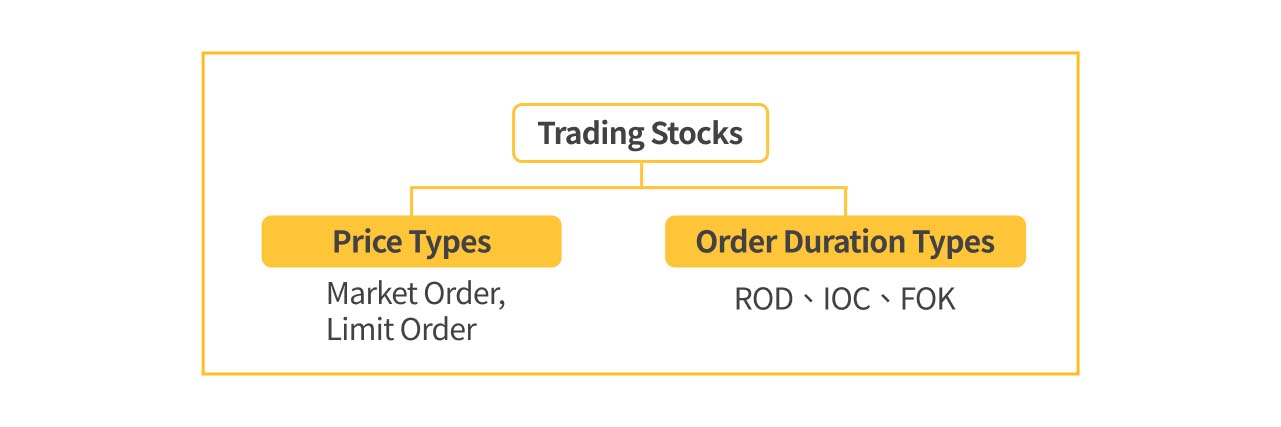Besides selecting the suitable stocks, the different types of stock orders are also important. Here, we categorized into three key aspects: price types, order duration types, and order timing.
For those unsure of how to start selecting stocks, you can refer to our article A must-read for stock market beginners! How to navigate the vast stock market: Five common stock classification methods

1. Price Types
Understanding the Difference Between Market and Limit Orders
While buying or selling a stock, the two most important things are deciding at what price and in what quantity to trade. Understanding the difference between market and limit orders allows you to better control the cost of your trades.
Market Orders: Execute at the Best Available Price
For some traders in certain situations, the price isn’t always the top priority. They prefer to complete the transaction as quickly as possible. Placing a market order allows them to achieve this goal. Market orders typically get executed faster, with a higher chance of completion.
Limit Orders: Execute at a Specified Price
Sometimes, traders might want to ensure that a transaction only happen at a specific price. In this case, a limit order is a good option. Limit orders only get executed if the price conditions are met. If there is no one else willing to trade at that price, the order will not be completed.
Defining the Price Condition:
- For buyers, you will need to set a maximum price for a limit order. The transaction won’t occur if the cost per unit exceeds this limit.
- For sellers, you will need to set a minimum price for a limit order. The transaction won’t occur if the return per unit is below this limit.
2. Order Duration Types
Understanding the Difference Between ROD, IOC, and FOK Orders
After deciding on the price, the next step would be determining the quantity for your to order. Following are the three order duration types, resulting in different final outcomes.
ROD (Rest of Day): Valid for the Day Only
This is often the default order type, where the order remains valid until the end of the trading day.
IOC (Immediate-or-Cancel): Partial Execution or Cancellation
This type of order allows for partial execution, but any unexecuted portion is immediately canceled. It’s commonly used with market orders.
FOK (Fill-or-Kill): All or Nothing
This type of order requires full execution; otherwise, the entire order is canceled.
3. Order Timing
Choosing Between Intraday and After-Hours Trading
When placing an order, you’ll usually see options to trade during intraday or after-hours sessions. Generally, people prefer to trade during market hours due to higher trading volume. However, trading opportunities still exist outside market hours.
In the U.S. stock market, both pre-market and after-hours trading allow transactions at flexible prices, similar to regular hours but with lower trading volume. In Taiwan’s stock market, only after-hours trading is available (pre-market sessions are limited to mock trades), and transactions are conducted at fixed prices with lower trading volume.
Below is a simple comparison of intraday and after-hours trading in Taiwan’s stock market:
| Intraday Trading | After-Hours Trading | |
|---|---|---|
| Order Acceptance Period | 08:30-13:30 | 14:00-14:30 |
| Trading Method | Continuous Matching | Batch Matching |
| Matching Period | 09:00-13:30 | 14:30 |
It’s important to note that if an order during after-hours trading isn’t executed, it won’t carry over to the next trading day.
Summary
How to Choose Between Market and Limit Orders?
- If you prioritize the price of the trade (price-focused): Choose a limit order.
- If you prioritize the speed of the trade (time-focused): Choose a market order.
How to Choose Between ROD, IOC, and FOK?
If partial execution is acceptable, and you want the order to be valid for the whole day: Choose ROD.
If partial execution is acceptable, but you don’t want the order to last the entire day: Choose IOC.
If partial execution is not acceptable, and you would only want all or nothing: Choose FOK.
